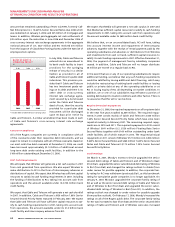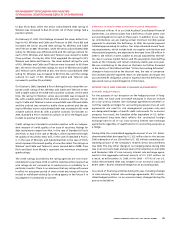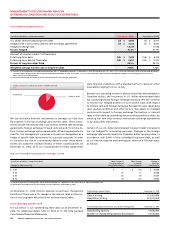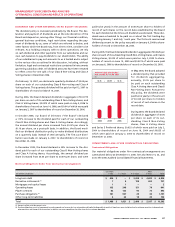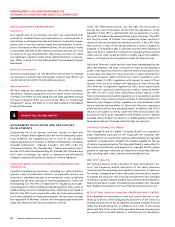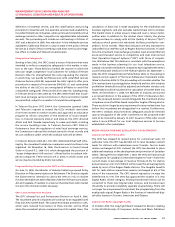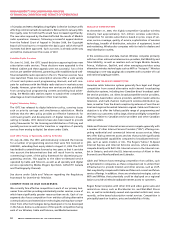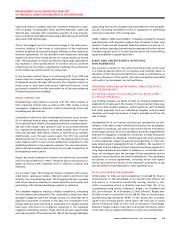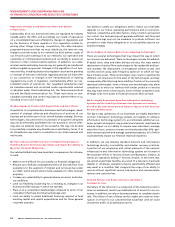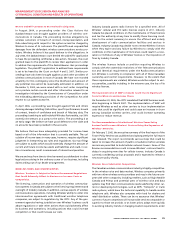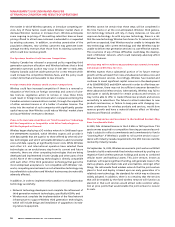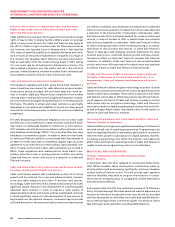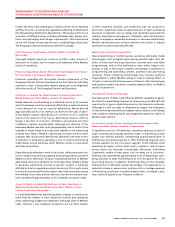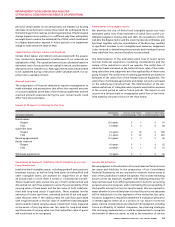Rogers 2006 Annual Report Download - page 57
Download and view the complete annual report
Please find page 57 of the 2006 Rogers annual report below. You can navigate through the pages in the report by either clicking on the pages listed below, or by using the keyword search tool below to find specific information within the annual report.
53
RO GER S CO MMU NIC AT ION S IN C . 20 0 6 ANN UA L RE POR T
MANAGEMENT’S DISCUSSION AND ANALYSIS
OF FINANCIAL CONDITION AND RESULTS OF OPERATIONS
Cable and Telecom competes with the incumbent telephone compa-
nies in Canada, including Bell, Telus, and MTS Allstream. Cable and
Telecom also competes with competitive suppliers of local, long dis-
tance, private line and data services using traditional circuit-switched
and newer VoIP technologies.
One of the biggest forces for potential change in the telecommu-
nications industry is the threat of substitution of the traditional
wireline telephone by new technologies. Wireless is often cited as an
eventual replacement for the standard home telephone, although
experience shows that mobile phones are used primarily as second
lines. The popularity of mobile phones among younger generations
has resulted in some abandonment of wireline service, but these
preferences are not likely to significantly challenge the prominence
of the traditional wireline phone for many years.
In the business market, there is a continuing shift from ATM and
frame relay (two common legacy data networking technologies) to
IP delivered services through VPN services. This transition results in
lower costs for both users and carriers. Cable and Telecom is well
positioned to benefit from this trend with one of the most advanced
IP networking solutions available.
MEDIA COMPETITION
Broadcasting’s radio stations compete with the other stations in
their respective market areas as well as with other media, such as
newspapers, magazines, television, outdoor advertising, direct mail
marketing and the Internet.
Competition within the radio broadcasting industry occurs primar-
ily in individual market areas, amongst individual market stations.
On a national level, Media’s Broadcasting division competes gener-
ally with other larger radio operators such as Corus Entertainment
Inc., Standard Broadcasting Inc. and CHUM Limited, each of which
owns and operates radio station clusters in markets across Canada.
Additionally, over the past several years the CRTC has granted
additional licences in various markets for the development of new
radio stations which in turn provide additional competition to the
established stations in the respective markets. Two new licenced sat-
ellite subscription-based radio services now provide competition to
Broadcasting’s radio stations.
Rogers Sportsnet competes for viewers and advertisers principally
with The Sports Network (“TSN”), Headline Sports and sports pro-
grams carried by other Canadian and U.S. television stations and
networks.
On a product level, The Shopping Channel competes with various
retail stores, catalogue retailers, Internet retailers and direct mail
retailers. On a broadcasting level, The Shopping Channel competes
with other television channels for viewer attention and loyalty, and
particularly with infomercials selling products on television.
The Canadian magazine industry is highly-competitive, competing
for both readers and advertisers. This competition comes from other
Canadian magazines and from foreign, mostly U.S., titles that sell in
significant quantities in Canada. In the past, the competition from
foreign titles has been restricted to competition for readers as there
have been restrictions on foreigners operating in the Canadian
magazine advertising market. These restrictions were significantly
reduced as a result of the enactment in 1999 of the Foreign Publishers
Advertising Services Act (Canada) and amendments to the Canadian
Tax Act. Increasing competition from U.S. magazines for advertising
revenues is expected in the coming years.
OMNI.1, OMNI.2, OMNI.10 and OMNI.11 compete principally for viewers
and advertisers with television stations that broadcast in their local
markets. These include Canadian television stations as well as U.S.
border stations, specialty channels and increasingly with other distant
Canadian signals and U.S. border stations given the time-shifting
capacity available to digital subscribers.
RI S K S A N D UNC E R TA I N T I ES A F F E C T I N G
OU R BUSI N ESS E S
Our business is subject to risks and uncertainties that could result
in a material adverse effect on our business and financial results. A
discussion of the risks and uncertainties to us and our subsidiaries, as
well as a discussion of the specific risks and uncertainties associated
with each of our businesses, are outlined below.
CORPOR ATE RISKS AND UNCERTAINTIES APPLICABLE TO RCI
AND ITS SUBSIDIARIES
Our Holding Com pany Structure May Limit Our Ability to Meet
Our Financial Obligations.
As a holding company, our ability to meet our financial obligations is
dependent primarily upon the receipt of interest and principal pay-
ments on intercompany advances, rental payments, cash dividends
and other payments from our subsidiaries together with proceeds
raised by us through the issuance of equity and debt and from the
sale of assets.
Substantially all of our business activities are operated by our sub-
sidiaries, other than certain centralized functions such as payables,
remittance processing, call centres and certain shared information
technology functions. All of our subsidiaries are distinct legal entities
and have no obligation, contingent or otherwise, to make funds avail-
able to us whether by dividends, interest payments, loans, advances
or other payments, subject to payment arrangements on intercom-
pany advances and management fees. In addition, the payment of
dividends and the making of loans, advances and other payments to
us by these subsidiaries are subject to statutory or contractual restric-
tions, are contingent upon the earnings of those subsidiaries and are
subject to various business and other considerations. The subsidiaries
are parties to various agreements, including certain loan agree-
ments, that restrict the ability of the respective subsidiaries to pay
cash dividends or make advances or other payments to us.
We Are Controlled by One Shareholder.
At December 31, 2006, we had outstanding 112,467,648 RCI Class A
Voting shares. To the knowledge of our directors and officers, the
only person or corporation beneficially owning, directly or indi-
rectly, or exercising control or direction over more than 10% of our
outstanding voting shares is Edward S. Rogers, our President and
CEO, and a director. As of December 31, 2006, Edward S. Rogers ben-
eficially owned or controlled 102,232,198 RCI Class A Voting shares,
representing approximately 90.9% of the issued and outstand-
ing RCI Class A Voting shares, which class is the only class of issued
shares carrying the right to vote in all circumstances. Accordingly,
Edward S. Rogers is able to elect all of our Board of Directors and to
control the vote on matters submitted to a vote of our shareholders.



